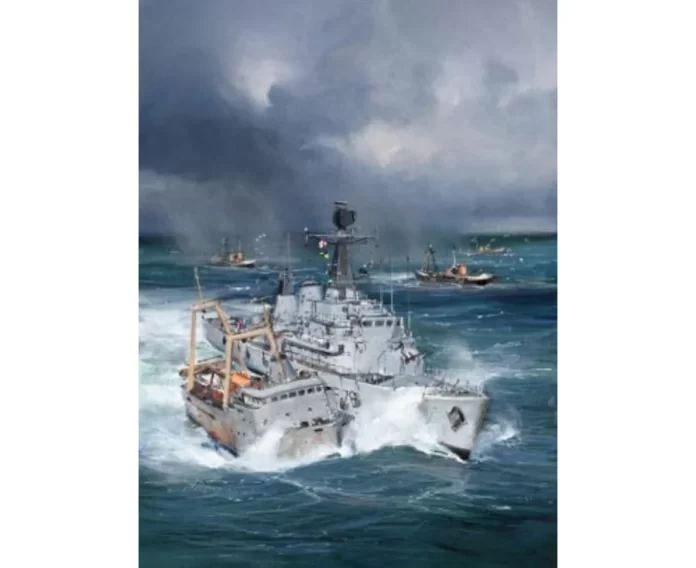
The Royal Navy and Fishery Protection. From the Fourteenth Century to the Present. By Jon Wise. Seaforth Publishing, Barnsley, 2023. ISBN 978-1-39904-170-6 (Hardback). ISBN 978-1-39904-172-0 (ePub)
Reviewed by David Hobbs
Jon Wise has a doctorate in Naval History from the University of Exeter and his previous books include The Royal Fleet Auxiliary, Vickers (Barrow) and The Royal Navy in South America. He is a regular contributor to the annual Warship. The Royal Navy and Fishery Protection is not just a fascinating study of a role that evolved before the formal creation of the Royal Navy itself but discusses wider issues including freedom of the seas, the importance of fishing within the British economy and the role of fishing vessels in the two world wars.
Six pages of bibliography reveal that author studied widely in his preparation before putting finger to keyboard; his sources include James Goldrick’s 2018 book Grey Zone Operations in the Maritime Domain. James’ career included time as a watchkeeping officer in a fishery protection vessel in the North Sea whilst on exchange service with the RN and his insight can be discerned throughout the text.
The book is mainly divided chronologically into chapters and the well-chosen images give a clear idea of many of the vessels mentioned in the text. There are five maps showing the various areas of operation which include the British Isles, the North Sea, North Norway, the Barents Sea, Iceland, Nova Scotia and Newfoundland. A forward by Rear Admiral John Lippiett, who commanded a fishery protection vessel as a Lieutenant, makes the point that the role has always given young officers an early chance to gain a wide range of experiences that would be valuable later in their careers. He also notes that, despite its long history, fishery protection is probably the naval commitment that the British public is least aware of.
One theme that runs through the book is the absolute belief in freedom of the seas held by successive British Governments since the Napoleonic Wars. The opening quotation by Sir Edward Grey, Foreign Secretary in 1911 makes this point emphatically, stating that Britain ‘had never admitted the right of any country to interfere with a British ship beyond the 3-mile limit…it was a principle on which we might be prepared to go to war with the strongest power in the world’. Unfortunately, the most notable clash over fishing rights in the twentieth century pitted the Royal Navy against one of the smallest nations, Iceland, in support of British vessels fishing in newly-claimed exclusion zones. In retrospect, it is difficult to comprehend how successive British Governments ordered three successive ‘Cod Wars’ to prevent Icelandic coastguard vessels interfering with British trawlers. They were conflicts that even the British press portrayed as ‘David and Goliath’ confrontations in which the British could never hope to achieve long-term success. International opinion favoured Iceland and now the UK has accepted exclusion zones and quotas that limit free access to fishing that have effectively ended the deep water fishing industry. Deep sea trawling operations from Hull and Grimsby are now just a memory.
Wise gives an overview of the various disputes with Norway, Russia and Iceland that evolved after territorial limits were extended from their three-mile, cannon shot, origins. Day by day accounts would be too lengthy so he has chosen interesting examples and described the men, ships and incidents to illustrate what happened. The growing importance of ‘winning the public relations battle’ is evident as international arguments grew. The role of the various UN conventions on the law of the sea are given due importance and, apart from the specific protection of historic fisheries, Wise gives an interesting perspective on the wider application of ‘soft’ naval power projection which sometimes developed ‘hard’ edges. It is important to study the reasons for this role and to apply that knowledge to contemporary situations.
Overall, this is a thoughtfully-written and well-researched book that will be of interest to both naval professionals and those responsible for the laws covering the unfettered movement of shipping across the oceans and within the vast economic exclusion zones that now exist. The problems and arguments that Wise describes focus on British fishing fleets and their protection when needed but they have much wider relevance and can be cross-referenced to many of the issues that complicate sea governance today, not least in the South China Sea. I thoroughly recommend it.



